Below, you can read the introductory “About This Guide” piece, and preview a few pages from our 15/16 Buyer’s Guide.
Our goal was to produce the best, most useful ski guide ever. While we’ll let you be the judge of that, we’re very pleased with how it turned out—it’s 174 pages of solid ski content.
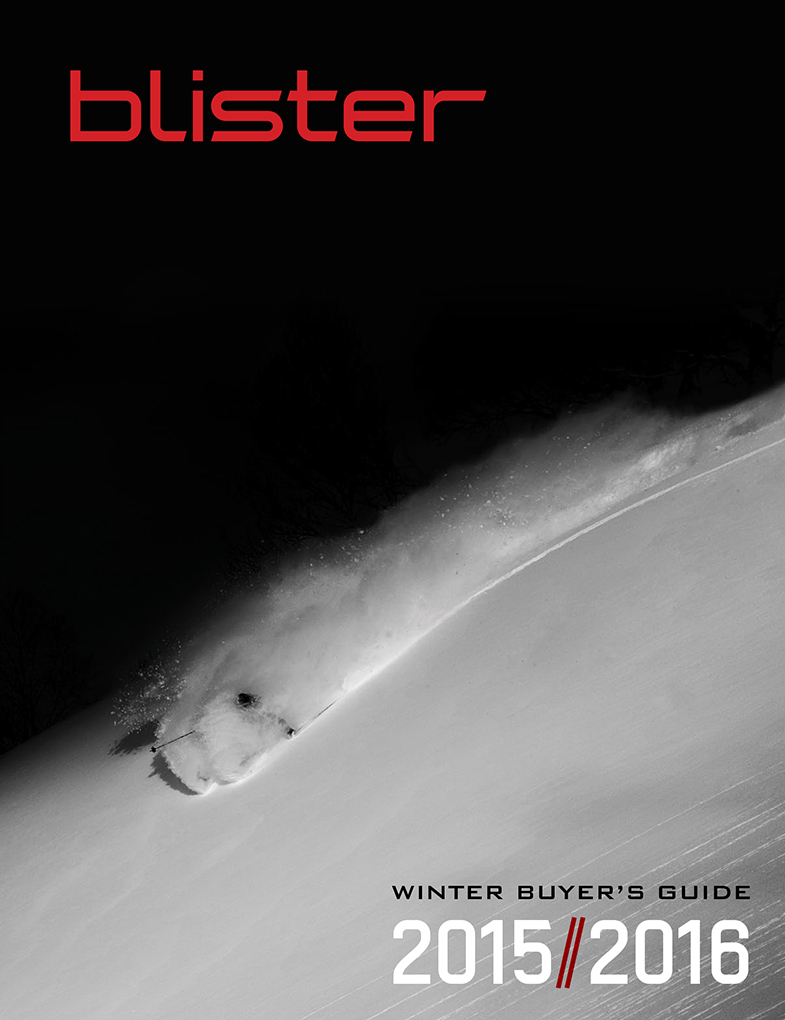
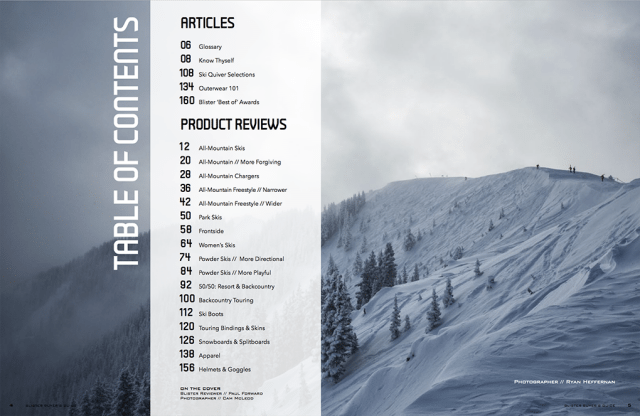
From the Intro to the Guide:
Building a Better Buyer’s Guide
We’ve always enjoyed flipping through ski magazines, but we always wondered why their Buyer’s Guides couldn’t be more useful? The descriptions are often overly cute: “Glide down hardpack, scoot through crud, knit through bumps…” —that’s an actual line from a recent Buyer’s Guide. We don’t know how to “scoot” through crud, but we do know that “scoot” and “knit” don’t tell us anything useful about the performance of a ski, and that there are far more accurate ways to describe what a ski does on snow.
And when those Buyer’s Guide descriptions aren’t flowery, they’re often empty: “This ski was ready to rock from turn one.” That’s another line from a prominent Buyer’s Guide. What does it mean? That this ski is different from all those skis that are only ready to “rock” after, what, turn 6 or 7?
When — and why — did we become ok with the fact that these Buyer’s Guides contain nice photos and little information? They’re Buyer’s Guides; shouldn’t they actually be helpful to buyers?
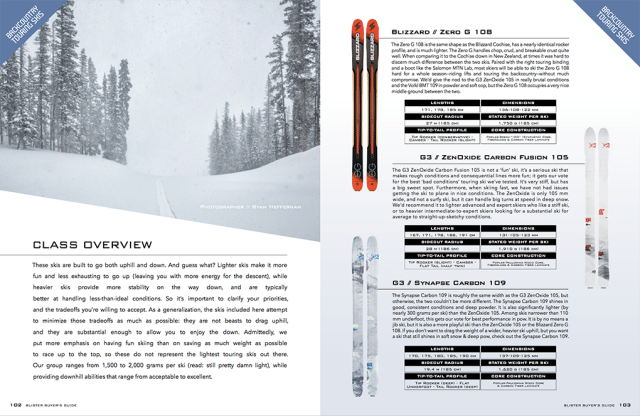
Unfortunately, it gets worse. In addition to being unhelpful, they’re sometimes just plain wrong. One of the major guides last year wrote about a ski that received “a full makeover that includes a wider chassis.” But that updated ski didn’t actually get any wider; it’s exactly the same width as the previous version. The name of the ski changed and the marketing department said it got wider, but it didn’t. (We measured.)
Good guidance requires real familiarity, and that’s a big part of the problem. Accurate descriptions, comparisons, and recommendations are only possible if you’ve spent enough time testing equipment to tease out the distinctions. The other ski publications only spend a few days a year testing products, and each tester only puts a run or two on the skis. We at Blister don’t believe it’s possible to learn how a ski performs in just a run or two.
How We Do Things
We test ski equipment every single month—first in the northern hemisphere, then in the southern hemisphere. And we don’t have our reviewers take just a run or two on a ski. We spend multiple days in a wide range of conditions on every single product we review. Nobody else puts in nearly as much time on equipment as we do, which is why nobody else can match the accuracy of Blister’s reviews and product comparisons.
Every year we spend thousands of hours on snow testing gear, and thousands of hours more writing up in-depth reviews. We go beyond the marketing departments to talk to experts in manufacturing and materials. We measure, compare, and take apart. Our Buyer’s Guide distills down all of this testing and writing into the most accurate, useful product descriptions of any ski guide out there.
Of course, accuracy is further enhanced when you remove conflicts of interest, which is why we take no money from the manufacturers whose products we review. Never have. If we’ve praised it or criticized it, you can be 100% certain that it’s because we mean it.
How to Use this Guide
Our Buyer’s Guide is a shortcut and supplement to the Blister website. It’s the readily digestible version of our full, 1,500-3,000 word reviews. With this guide, you can easily identify the products that sound most interesting to you, then head over to the site to read our in-depth reviews to see which will be the best fit.
Blister Spectrums
In addition to our Class Overviews at the front of each ski section, and our descriptions of each product, we wanted to help you better understand the differences between skis. With this in mind, we’ve ranked the skis in each class relative to one another—on a series of “Blister Spectrums”—according to relevant, class-specific criteria (e.g., stability, edge hold, flotation, playfulness, etc.). If skis are listed right next to each other, you can assume their performance is similar. But if a ski is ranked 2 or 3 spots higher than another? That’s worth noting.
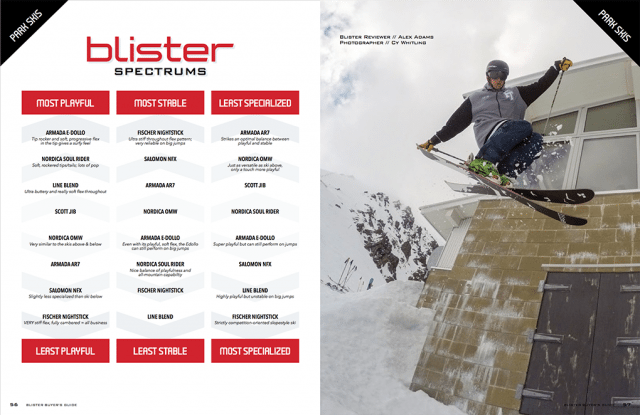
Of course, anyone could slap together continuums like these and throw a bunch of skis in there. But once again, to do that meaningfully, you have to first spend enough time testing to be accurate. We have put the time in, and in conjunction with our Class Overviews and our individual product descriptions, we think you’ll find the Blister Spectrums to be very useful when trying to figure out which ski in a given category is the best fit for you, given where and how you ski.
Our Photos
Any Buyer’s Guide worth its salt should feature great photos. What’s unique about our guide is that every skier or boarder pictured here is an actual Blister reviewer, on gear that he or she was testing at the time.
Bottom Line
Buyer’s Guides don’t have to suck, you just have to commit to doing things a better way. If you don’t like to be misled, and you like the sound of a guide that provides clear, accurate, and useful information, then you’re exactly the person we built this guide for.
And this is just the beginning. We know we can do more, so we’re already working to make next year’s Buyer’s Guide even better.
Thanks for being with us from the start.

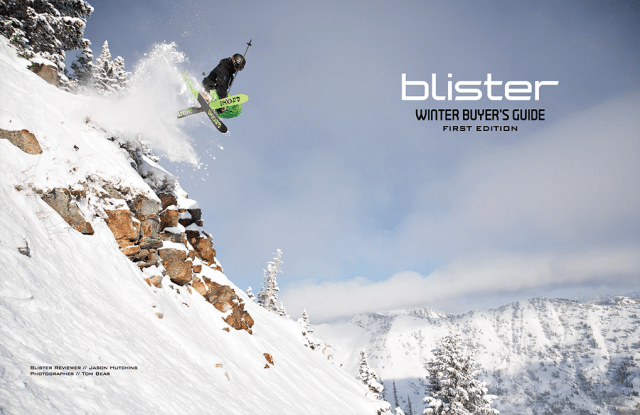

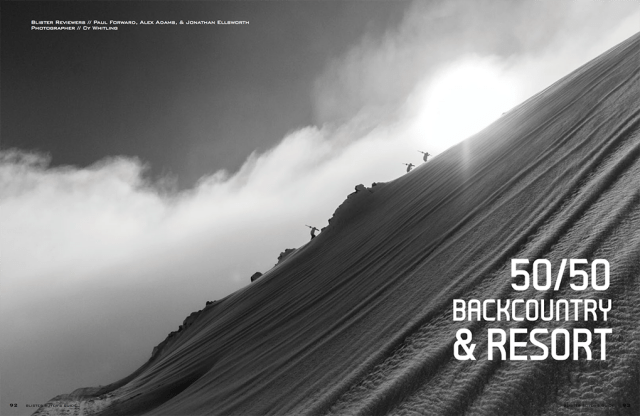
How about the Blister Kids section? You know, for the kids that want to (and are) freeride the big mountain as their skills build. Pass on the bloated over obsessed youth race B.S. the industry loves. Hard money goes down for my son’s gear and the good stuff needs exposure.
Interested in ski and boot reviews. I’m 74 with just medium skills. So-I like groomers. Powder under the “right” circumstances. I see you refer to “Park” skies-no idea what that means. I guess groomer skies are “Front Side”?
Looking forward to your reviews and general information.
Thank You,
Gary
‘